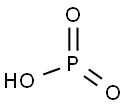Metaphosphoric acid is a singularly anhydrous
version of orthophosphoric acid and is
sometimes used as a water- or moisture-absorbing
reagent. Metaphosphoric acid has phosphorus in the
formal oxidation state of +5. Although it has several
CAS numbers: 10343-62-1, 135306-83-1, 13566-25-1, and
37267-86-0, only the last two are associated with the
IUPAC name “phosphenic acid”.
Metaphosphoric acid units can be bonded together in
rings (cyclic structures), chains (catena), or branched by
condensation yielding water as each acid unit is added.
These structures consist of linked metaphosphoric acid
molecules. For example, trimetaphosphoric acid is the
simplest cyclophosphoric acid. Metaphosphoric acid
would need to share the doubly bonded oxygen with
neighboring phosphorus atoms to form polymers itself.
Many oligamers are possible with the alkaline earths but
the trimetaphosphates and hexametaphosphates seem
to be the most prevalent.
